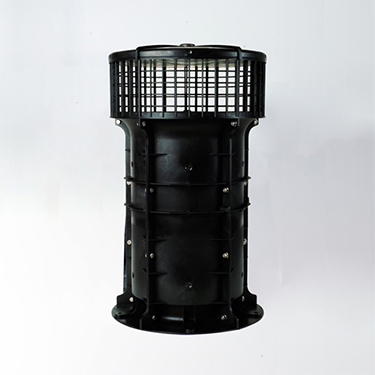To make sure we feel comfortable in our own four walls, it’s important to have not just an appropriate setting, but above all a pleasant room climate. However, vapors from objects, as well as biochemical processes such as breathing or sweating, reduce the air quality in homes. The humidity also rises when cooking, showering or doing laundry – if there is no adequate ventilation, mold can grow. This damages rooms and their inhabitants.
These problems can be prevented with efficient room ventilation. But many homes are empty a lot of the time, as the residents are at work or engaged in other activities out of the house. However, most ventilation systems work at constant air flow – even in situations where this is not necessary at all. So they consume energy unnecessarily. In the event of high activity in the rooms, on the other hand, air exchange is often not sufficient to improve the air quality. This is why French manufacturer AERECO has developed demand-based ventilation. The system adapts its performance to the use of space and only works when it is really needed.

Fresh air flows into the building through air outlets at the windows (1). In exhaust air rooms, a demand-driven humidity-controlled exhaust air element (2) guides the air into the exhaust air shaft. Hybrid fans on the roof (3) adjust their speed depending on the outside temperatures. (Illustration | AERECO)
Sensors control inlet and exhaust air flaps
It works as follows: AERECO sensors measure air quality in the home using several parameters. If the quality drops, the system opens the flaps installed in outside air ducts in the living and sleeping areas, thereby automatically replacing the required air volume. For example, if the humidity in the home rises, the flaps open more and more fresh outside air is let in. Connected exhaust air elements also work this way in kitchens, bathrooms and WCs: They extract the air more quickly.
Support for free ventilation
AERECO relies on hybrid ventilation, i.e. the combination of free and fan-supported ventilation. A low-pressure fan designed for this purpose generates a constant underpressure in the shaft. If the thermal lift is not sufficient, the fan switches on automatically, thus supporting the ventilation system. Various hybrid ventilation systems mounted on the building roof ensure that this is done quickly and efficiently: The VBP product family with low air performance levels of up to 400 m3/h, the VBP+ devices for high air performance of up to 800 m3/h and the fire-proof fans of the VBP+C4 series.

Hybrid ventilation combines free ventilation with fan-assisted ventilation. (Photo | AERECO)
The individual rotor blades of the VBP low-pressure ventilation unit run parallel to the air flow. This means that the entire free cross-section of the shaft is available, which ensures shaft ventilation even without mechanical support. To drive the fan, AERECO uses an ebm-papst EC motor with separate commutation electronics. Reliability was crucial when selecting the components. The motor’s durability was particularly important to the company. ebm-papst’s products also have a good reputation among end customers. The motor circuit board is in a plastic box and the cable’s structure is simple. The electronics box in a separate location can be mounted outside the air flow. The connection box can thus be installed in an easily accessible position on the ventilation unit.
Depending on the outside temperature, a power supply and control unit controls up to 25 ventilation units and switches them from the basic speed that prevents freezing in winter to the required speed. A VBP ventilation unit can ventilate multi-family homes with up to seven stories and can also be mounted on existing shafts.
Maximum power, minimum consumption
The VBP+ hybrid ventilation unit provides an advantage in terms of energy efficiency. It operates at 35 W with an air performance of 800 m3/h, reducing energy consumption to a minimum. An ebm-papst EC motor also contributes to this. For AERECO, it was very important to have an efficient drive that helps significantly reduce energy consumption while also operating reliably.
With a housing made of galvanized steel and a matrix of calcium silicate that protects the motor, the ventilation unit can withstand temperatures of up to 400 degrees Celsius for up to 30 minutes.
The ventilation system automatically adapts to the weather conditions, ensuring a constant underpressure at all times. The VBP+ C4 is also suitable for smoke in the event of a fire. With a housing made of galvanized steel and a matrix of calcium silicate that protects the motor, the ventilation unit can withstand temperatures of up to 400 degrees Celsius for up to 30 minutes.
In use whenever necessary
Thanks to the presence detection and CO2 or VOC sensors in residential areas, the fans are only switched on when air actually needs to be extracted. If the house is empty, the ventilation system automatically reduces the air exchange; the fresh air supply and exhaust air flow are then reduced. This saves heating energy, reduces the current consumption of the ventilation units – and ensures good air throughout the house at all times.

Leave a comment